Sous Vide Poached Eggs (with easy hollandaise)
Oh perfect poached egg. No swirling in vinegar water. No standing over the stove worrying about overcooking. And no wispy whites floating in the water. Sous vide poached eggs are simply little miracles, every time. Top them with an easy sous vide hollandaise – yum!
With a few tips and tricks, you’re good to go. We’ve done all the research to make you a pro. And tested a LOT of eggs.
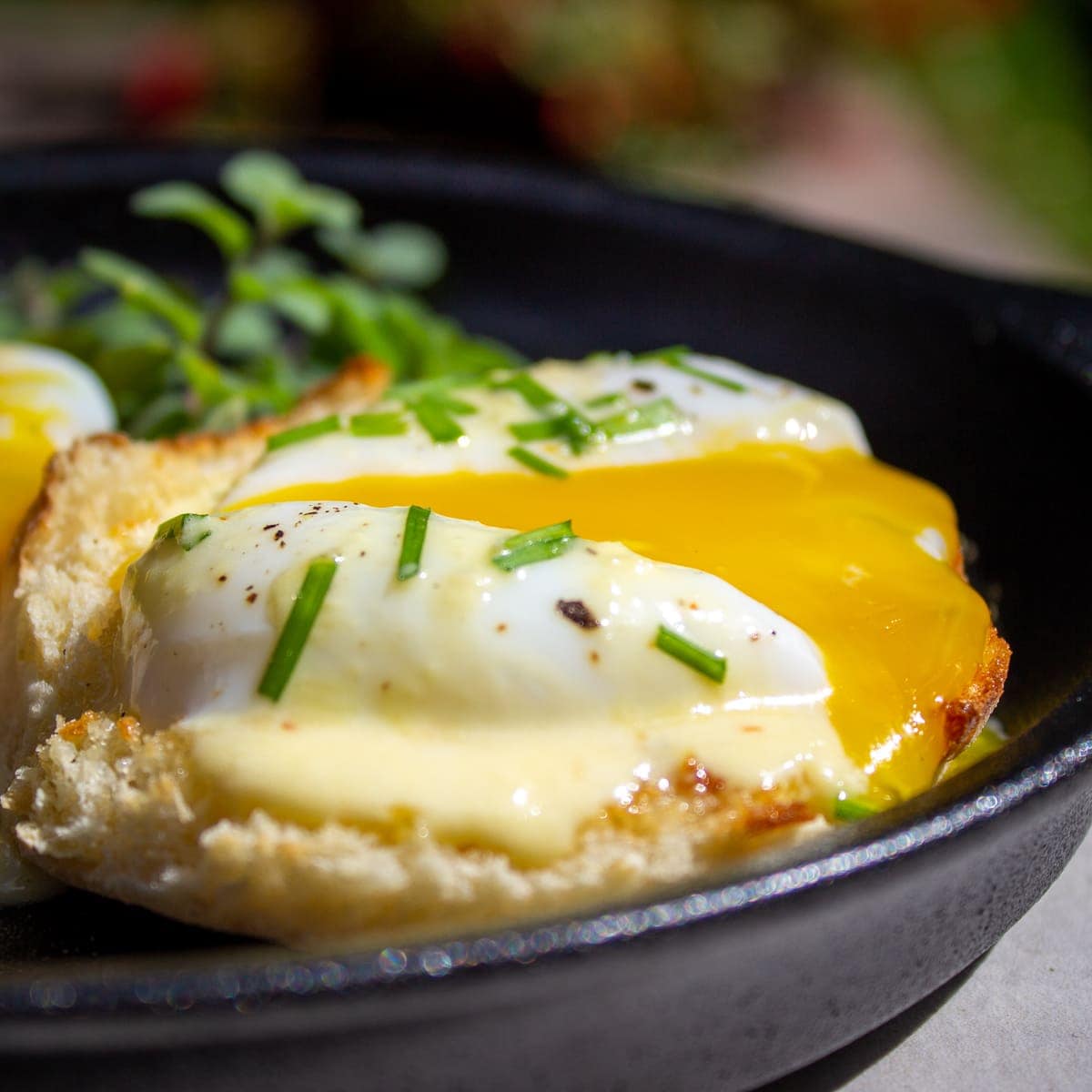
Technically these eggs aren’t sous vide eggs because they are cooked right in their shell – not in a [vacuum] sealed bag.
And technically they are not poached eggs as they are not cooked directly in boiling water.
Soft boiled eggs perhaps? Whatever. Call them what you want. The sous vide method works beautifully.

Why sous vide eggs? What to expect
The pros
- Once you figure out the timing for your perfect sous vide egg based on your personal taste, you will get a perfect result – 100% consistent every time.
- All the cooking time is hands-off. And there is no vinegar taste that you sometimes get with the traditional poached egg method.
- There is no frustrating shell peeling required. The poached egg slips right out of the shell, yolk and egg intact. We all know eggs have a mind of their own. I’ve tried many peeling tricks for regular eggs. Sometimes they work. Sometimes they don’t.
- You can make sous vide poached eggs for a crowd – up to 16 at once – according to America’s Test Kitchen. That would be a difficult feat with traditional poached eggs.
- Make these eggs up to 5 days ahead and keep them in the fridge. We have several options for reheating.
- You can make a very easy, silky smooth sous vide hollandaise in a minute with one of the sous vide eggs you are cooking. Instructions are in the recipe.
The cons
- Unlike many other sous vide recipes where an extra hour of cooking might not matter, the timing for the eggs is quite precise IF using the quick method. You have to pay attention. If you want a more forgiving method, use the slower, higher temp method.
- A small amount of white will remain stuck in the shell when you turn out the egg. So less white on your egg. Not a big deal for me. The whites may be a little less firm than you’re used to.
Ingredients – tailored to your taste

Eggs: Start with fresh cold eggs, no cracks.
Hollandaise sauce: This includes an egg, lemon juice and butter.
Variations to try:
- Garnish: Top the eggs with fresh chives or fresh dill; hollandaise sauce using the hollandaise recipe below; or with everything bagel seasoning.
- Serving options: See the many ways use sous vide poached eggs below.
- Egg doneness: Choose how the time and temperature you prefer to make your eggs the way you like them.
How to make poached eggs sous vide (with hollandaise)
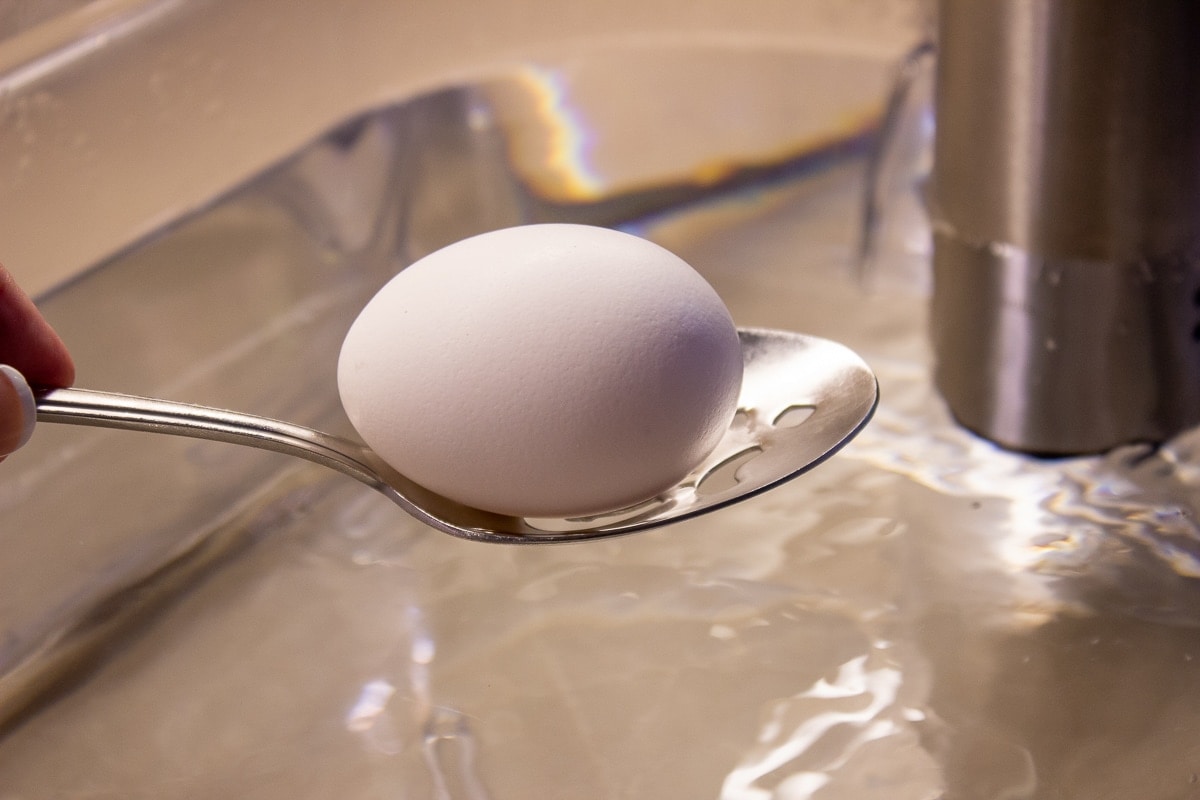
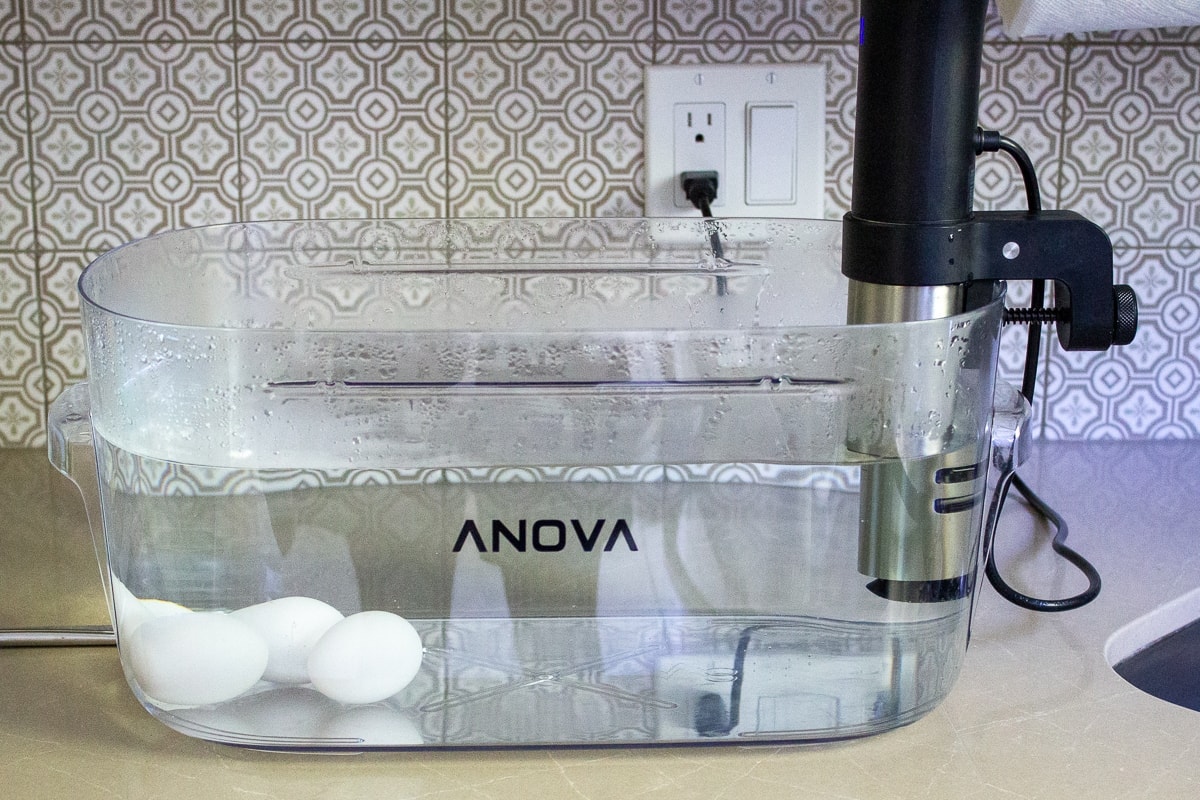
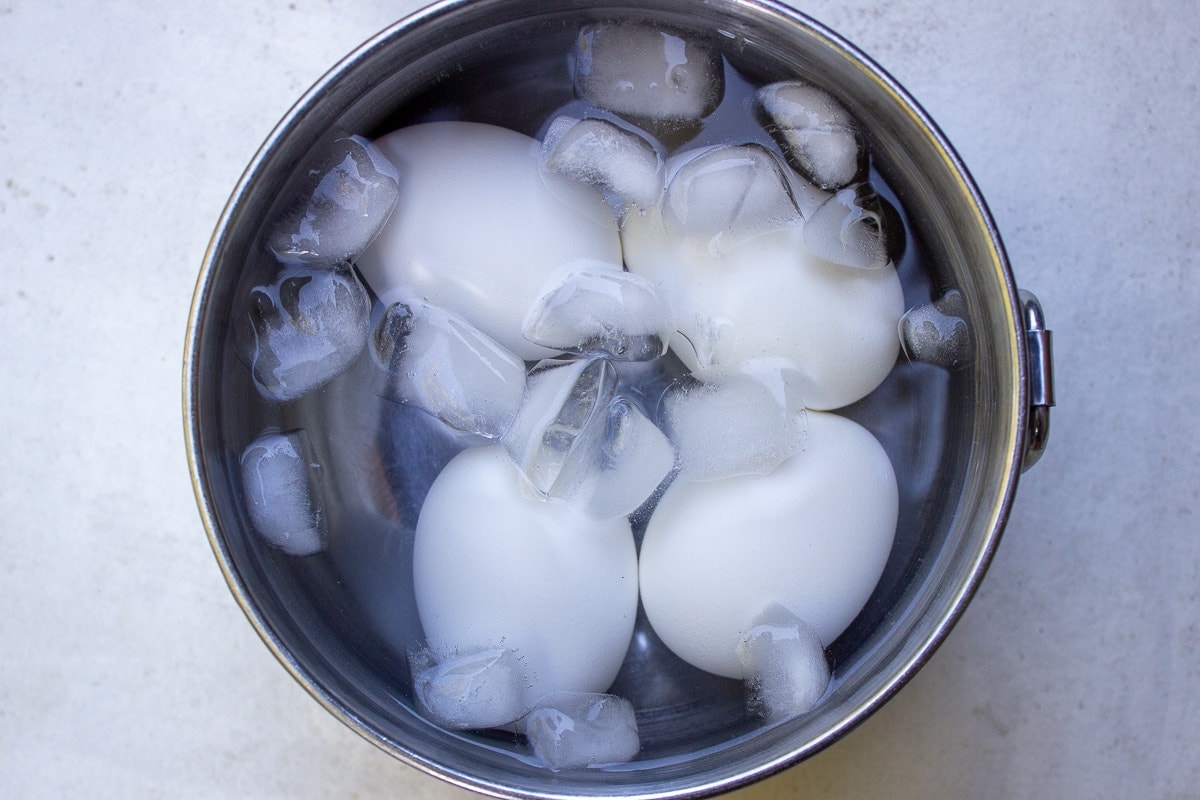
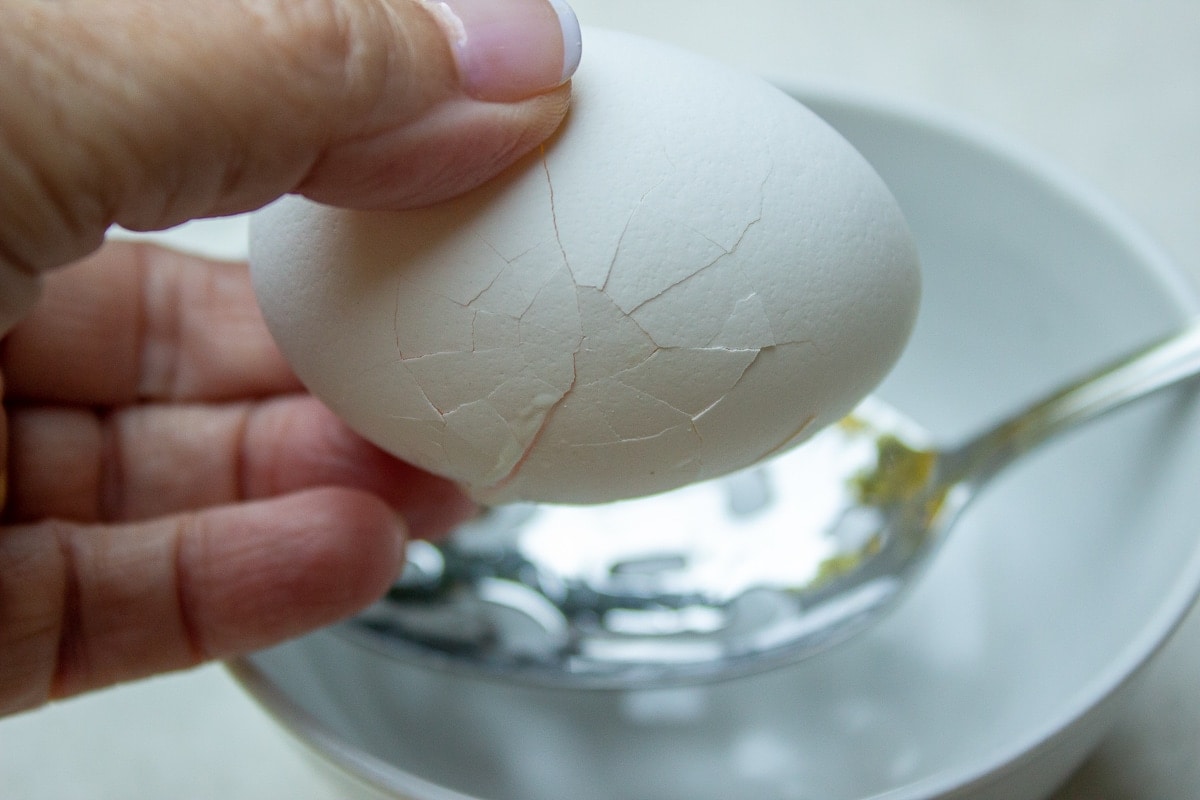

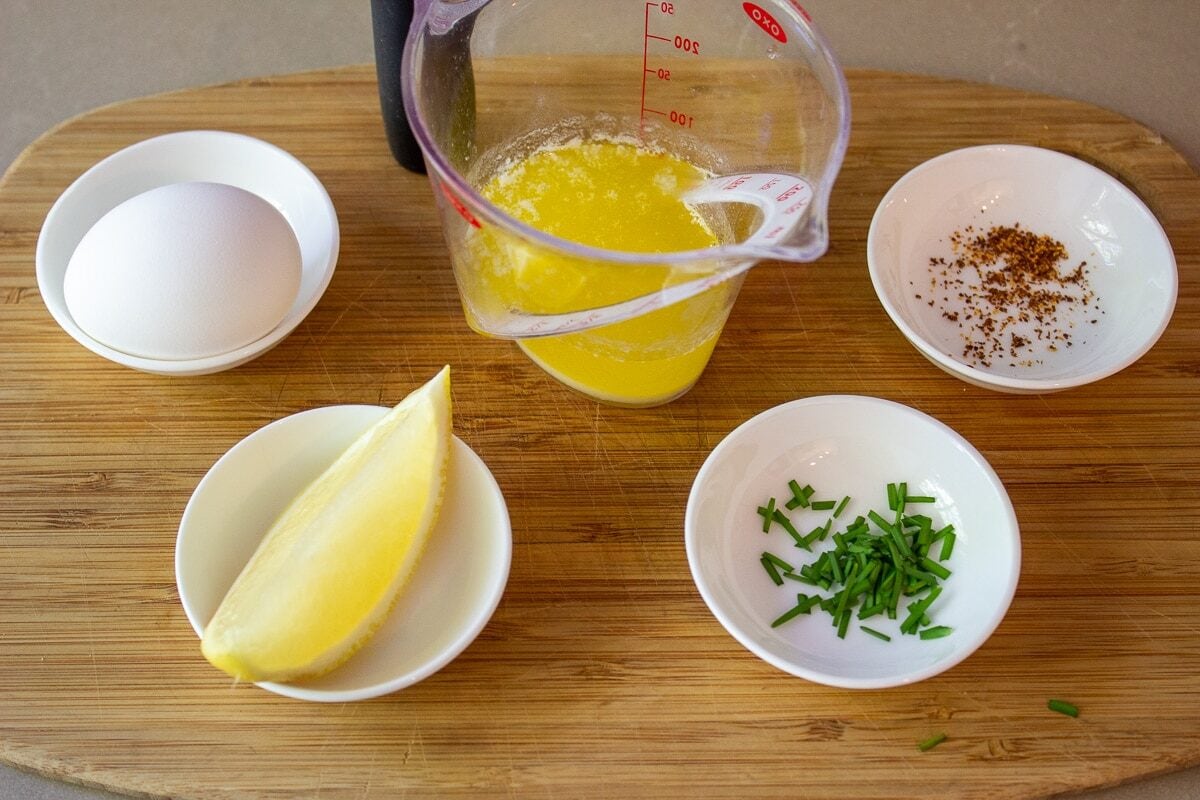
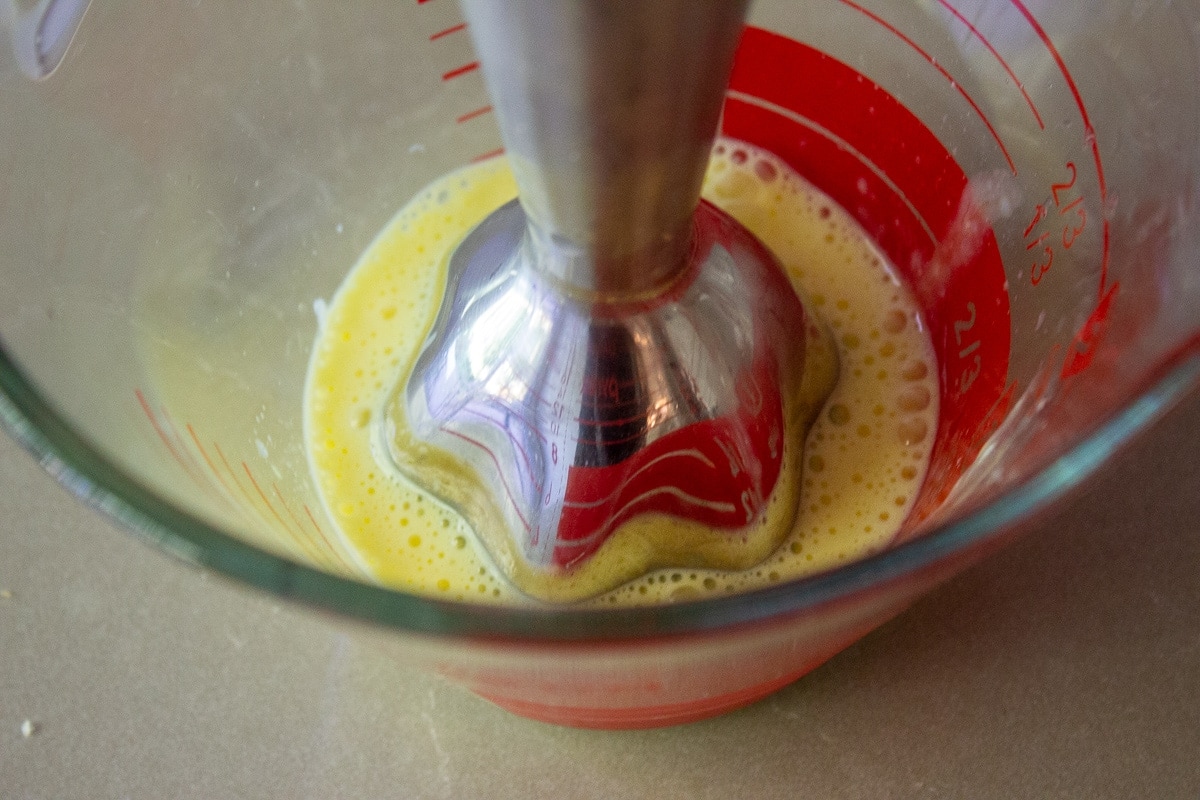
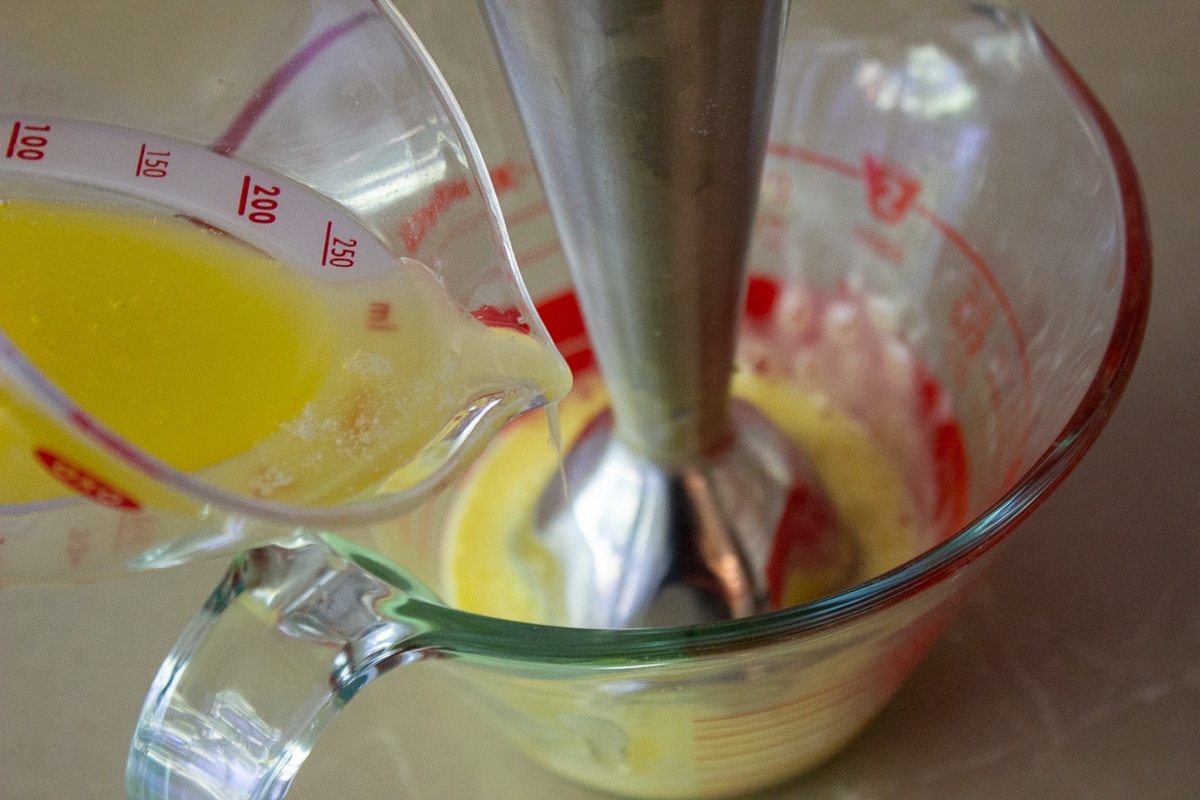
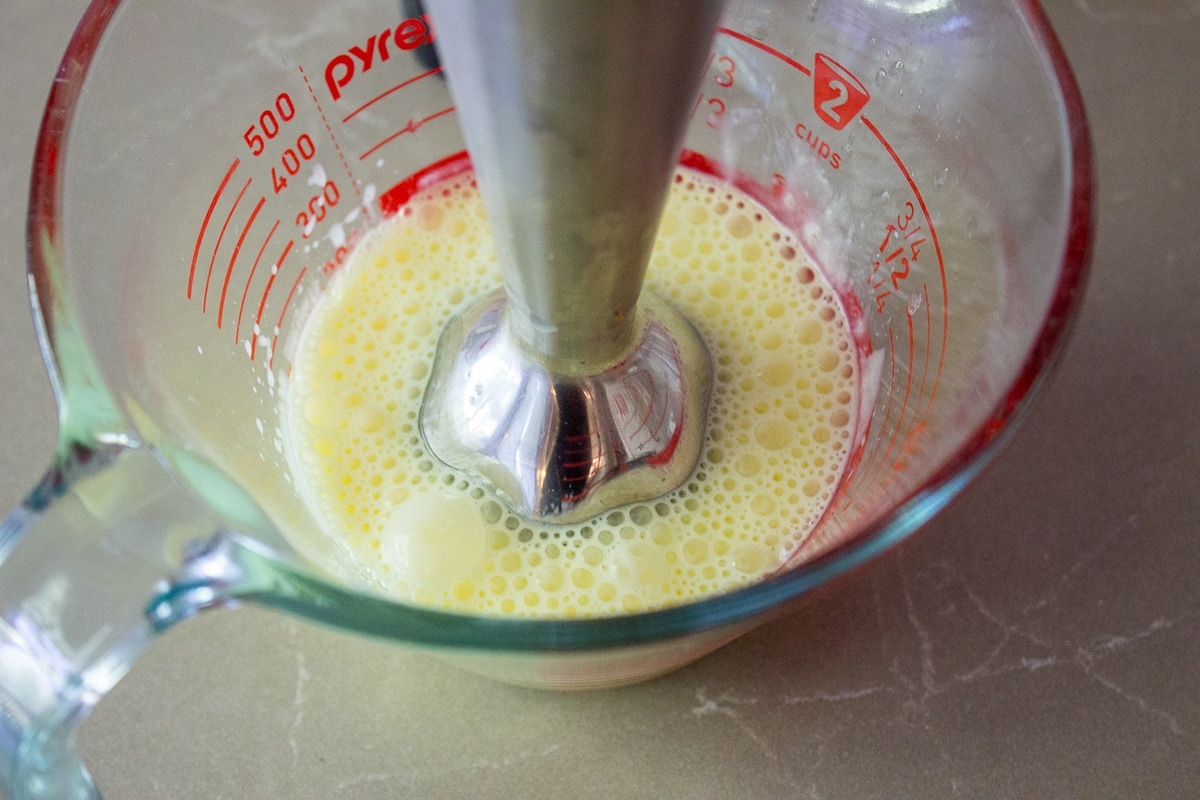
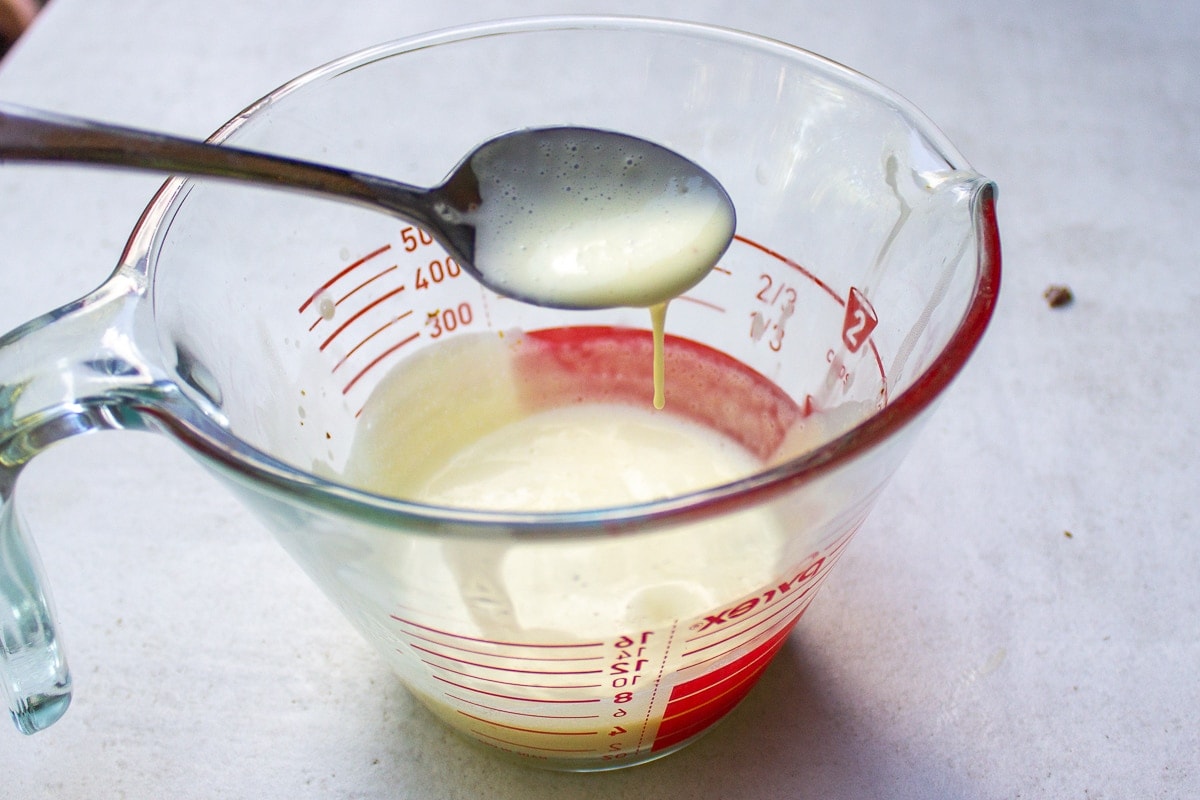
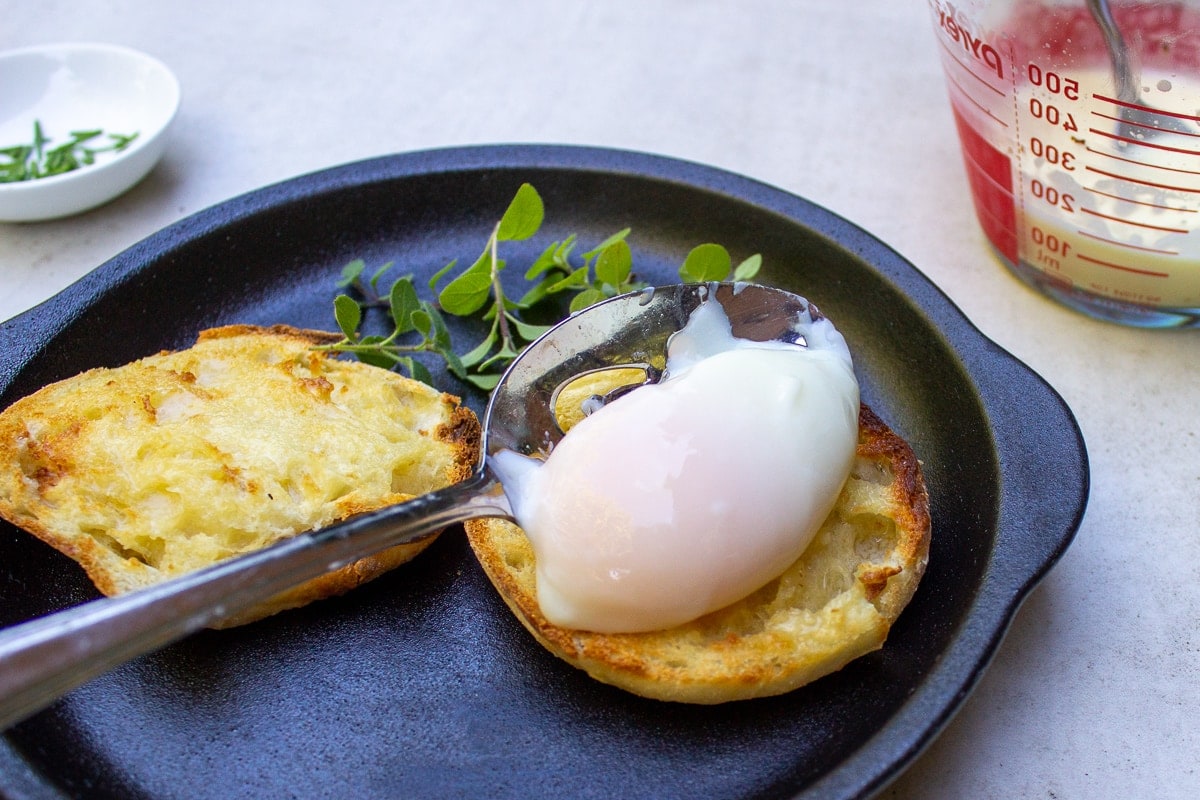

Temperature and Timing
Here’s the thing. You will have to experiment to determine the time and temperature for your perfect sous vide poached egg. The two most popular times and temps are as follows. They both have pros and cons.
Option 1: 167F/75C for 13 minutes.
This is my preferred way. It will create a soft, creamy egg yolk and a light, firmed up white. And it’s much quicker than option 2, but a bit more finicky. The eggs can over cook easily so it’s best to do a test for the best time that works for you.
Tweak the timing as you like with plus or minus 30-60 seconds…
- 12 minutes will be looser and runnier.
- 13 minutes and 30 seconds will have a slightly less runny yolk and tighter whites.
- 14 minutes slightly more custardy egg yolks and tighter whites.
If you are making more than 4 eggs at a time, you may need to add an extra 30-60 seconds. Or if your eggs are very large, up to 2 minutes extra (total 15 minutes)
Option 2: 145F/63C for 45-60 minutes.
With this time and lower water temperature, the egg yolks will be fairly runny and part of the whites will be a bit watery. You can let the watery white part fall away when you lift the egg with a spoon to its destination e.g. toast.
On the plus side:
- the timing is more forgiving, and
- once the eggs are cooked, you can lower the temperature of the water bath to 140F/60C and keep the eggs warm for up to 2 hours.
If you are interested in the science, details and background for the sous vide method for eggs, check out this guide to sous vide eggs by Serious Eats.
Tips for perfect sous vide poached eggs
- Start with fresh eggs, cold out of the fridge. Several experts say starting with cold eggs is best, but I’ve tried room temperature eggs and they work fine too.
- Make sure there are no cracks in the eggs. And use a (slotted) spoon to lower eggs gently into the water to avoid cracks.
- DO A TEST to determine the perfect doneness for your poached egg. It’s worth the extra 15 minutes the first time you try sous vide poached eggs.
- Set a timer if you’re doing a 13 minute egg. (Don’t use the timer on your immersion circulator – it won’t be accurate for this purpose.)
- Once cooked, place eggs into a bowl of ice water for 60 seconds to allow for easy handling and to tighten up the whites. Even 30 seconds should be ok.
- To crack the eggs open, tap firmly on the counter (not the side of a bowl), then separate the broken part of the shell with your two thumbs, letting the egg slip out into a bowl
- Use a slotted spoon to transfer the egg to your toast, English muffin halves or other food. This will allow any loose white to remain in the bowl. Or use a soup spoon and let the loose white part fall way when you lift the egg.
Sous vide hollandaise is brilliant
If you have ever made your own hollandaise, you will know it’s tricky and very easy to mess up.
Sous vide hollandaise is pretty much foolproof. I have made it many times and never had a problem. So easy! Takes less than a minute with a sous vide egg.
I used a recipe from Lisa Fetterman’s Sous Vide at Home cookbook and tweaked it to use half the butter. It worked great. It’s on the thinner side (with the lower amount of butter), but still rich and silky. And it’s the easiest recipe I have found.
Here are two other sous vide hollandaise recipes to try if you prefer with different methods.
- made in a jar, by A Duck’s Oven
- made in a ziplock bag, by Savoring the Good
How to use sous vide poached eggs
- on toast or English muffins. Try our homemade English muffins (easy step by step)
- in classic eggs benedict with an English muffin topped with a slice of Canadian bacon (or smoked salmon or spinach), the poached egg and drizzled with hollandaise
- straight out of a bowl with dipping toast
- on avocado toast
- in shakshuka
- as a topping for an Asian noodle bowl like our dynamite noodle bowl recipe
- over a vegetarian sweet potato hash
- over Chinese vegetable fried rice
Make Ahead
See the notes in the recipe card below for make-ahead instructions for both the eggs and the hollandaise sauce.
Love sous vide cooking?
Then try our best sous vide recipes (with tips on sous vide cooking)
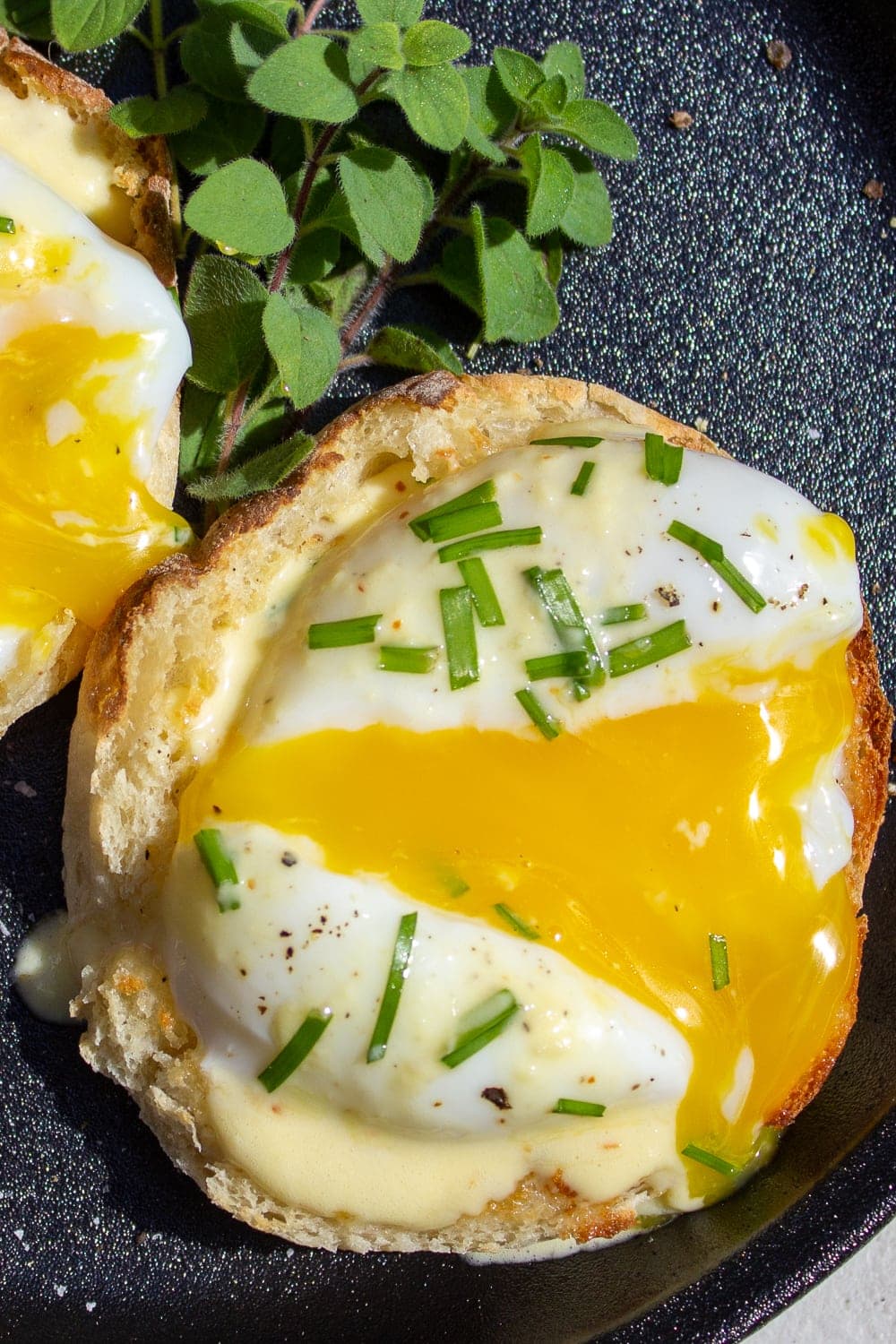
More breakfast ideas
- Gordon Ramsay scrambled eggs
- apple French toast casserole
- baked French toast casserole (sinful!)
- Montreal bagel recipe
- lemon blueberry pancakes
- super moist banana bread (no mixer needed)
- ricotta pancake recipe with caramelized bananas
- pumpkin spice pancakes
- make ahead breakfast burritos with caramelized onions
- easy potato skillet breakfast with ham
- Dutch pancake recipe (also called German pancake)
- Instant pot oatmeal recipe (with rolled or steel oats)
Or check out our full list of vegetarian brunch recipes for Mother’s Day.
Sous Vide Poached Eggs (with easy Hollandaise)
Equipment
- sous vide immersion circulator or sous vide machine; immersion blender or blender (if making hollandaise)
Ingredients
- 5 large fresh eggs (or 4 if you are not making hollandaise) no cracks
sous vide hollandaise sauce (optional), Note 2
- use 1 (of the 5) cooked sous vide eggs
- 1 teaspoon -2 lemon juice
- 4 tablespoons (68g) butter, melted and warm 1/2 stick
- pinch cayenne pepper (optional)
- pinch salt (if you used unsalted butter)
Garnish (optional)
- chopped fresh chives or dill, pepper, everything bagel seasoning, flaky sea salt
Instructions
- HEAT SOUS VIDE WATER BATH: to 167F/75C, If you're only making a few eggs, you can use a smaller pot. Note 1 for slower cooked sous vide eggs that can be kept warm for up to 2 hours.
- SOUS VIDE EGGS: Lower eggs gently one at a time with a spoon into the water bath to avoid cracking. Immediately set separate timer for 13 minutes (plus or minus 30-60 seconds).
- COOL EGGS: When cooking is finished, transfer eggs to bowl of ice water for 30-60 seconds to cool down enough to handle and to tighten up whites.
- REMOVE 'POACHED' EGGS FROM SHELLS: Have shallow bowl ready. To crack egg, tap one side of egg firmly on counter (not the side of a bowl). With two thumbs, separate shell over bowl, letting egg slip out. Repeat with remaining eggs, leaving one egg for hollandaise sauce (if making).
- MAKE HOLLANDAISE (optional): Crack the one remaining egg into a measuring cup (large enough to fit an immersion blender) or a blender. Add 1-2 teaspoons lemon juice and pinch of cayenne pepper if desired. Blend with immersion blender (or blender) for 10 seconds. Slowly add warm melted butter in a stream while continuing to blend for another 10-20 seconds or until smooth and frothy. Taste and adjust with more lemon, cayenne, salt (if you used unsalted butter).
- PLATE AND SERVE: Transfer the eggs using a soup or slotted spoon to your buttered toast or a serving bowl. Drizzle with hollandaise and garnish as desired.
Video
Recipe Notes
-
Alternate timing and temperatures.
- For slower cooked sous vide poached eggs, use 145F/63C for 45-60 minutes. The timing is more forgiving, and once the eggs are cooked, you can lower the temperature of the water bath to 140F/60C and keep the eggs warm for up to 2 hours. The whites, however, will be less tight/looser. You can let the watery white part fall away when you lift the egg with a spoon to its destination e.g. toast.
- If you are making more than 4 eggs at a time, you may need to add an extra 30-60 seconds to your chosen time and temp. Or if your eggs are very large, you made need to add up to 2 minutes extra
- Hollandaise sauce: the recipe above makes enough for at least 4 eggs (or more, depending on how much sauce you like). You can double the recipe, but you will need to sous vide an extra egg.
- Make ahead
- To make the eggs up to 5 days in advance, cool the eggs in their shells in an ice bath for 5 minutes, then place them in the fridge in an airtight container.
- To reheat an egg:
- Option 1: Microwave a cup of water for 1 minute, add the egg to the hot water and let it sit there for 12-15 minutes while you make coffee, toast, etc.
- Option 2: Simmer water in a small sauce pan on the stove. Add the egg for 60 seconds.
- Option 3: Heat sous vide water bath to 140F/60C. Lower egg into water and warm for 15 minutes, up to 60 minutes.
- Hollandaise can be made up to 2 days ahead. To reheat, microwave at 50% power for 1 minute, whisk, then add 15 second intervals if not heated through in the one minute, whisking in between. Do NOT overheat as it will turn to eggy custard. Alternatively, heat on low on the stove or in double boiler, very gently, stirring regularly.



